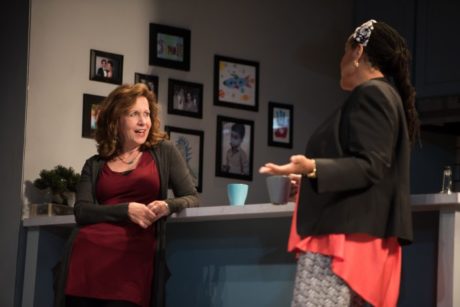Susan Miller’s 20th Century Blues, which opened last weekend at Shepherdstown’s Contemporary American Festival, speaks right from the heart of successful, east coast boomer women.

Four 60-something women meet for the 40th annual anniversary of the night they spent in jail in the 1970s. Each year, Danny, the photographer, has captured their group’s heart and soul in black and white.
Now, with her career at its zenith, and the New York Museum of Modern Art doing a retrospective of her photographs, Danny wants to use those four decades of never-before-viewed photographs as the embodiment of her work.
The change in the private vs. public status of these photographs initiates concern among the women, as their “lives” will suddenly be on display.
And 20th Century Blues, a theatrical blues play of a kind —minus, of course, the deep hardship of poverty that birthed the blues in the first place—soars right to the heart: an inspirational soul-play on women’s bodies, on women’s faces, on women’s beings, as they personify the trials and tribulations life necessarily brings.

Betzy Aidem (Danny), Alexandra Neil (Sil), Fanchelle Stewart Dorn (Mac), and Kathryn Grody (Gabby) play this quarto of women with much love and affection as together they celebrate their enduring friendships in a world where transience has become the hallmark.
More than blues, however, 20th Century Blues is a fugue, both musically and psychologically, on the disorientation aging offers its recipients, as each woman plays her melody to a changing of the guard and, in the process, struggles to hold on to her identity.
Mac, a Senior Editor and “muckracking” journalist of the old school, faces stoically the death of investigative journalism and, thus, her own career.
Sil, whose wealthy republican lawyer husband dumped her, once leaving her temporarily homeless, albeit in the shi shi Manhattan flat she was attempting to sell, can no longer stand to look at the multiplying age-lines in her face.
Gabby, the veterinarian, obsesses that her husband might soon die and leave her alone; so, now, she ventures out alone in various trial runs on independent living.
Danny—well, with national prominence staring her in the face, she wants to turn her friendships into a work of art to illustrate the endurance, the beauty, and the grace that only time can reveal.
Although Miller’s play still has the minor expositional flaws that one might expect in a world premiere, where back story and lead story sometimes jar with confusion or a “that doesn’t make logical sense” kind of feeling, 20th Century Blues offers its testimony to friendship to a theater audience hungry for representation.

In other words, you could not ask for a play that better synchronizes with its audience: the sense of identification was palpable.
Another plot line in 20th Century Blues, which this reviewer found interesting even if unnecessary to the play’s focus, i.e., the celebration of enduring friendship, involved Danny’s aging, Alzheimic mother (Mary Suib) and adoptive son (Jason Babinsky).
One could argue that this plot tangent clarifies Danny’s need to use her friend’s photographs in her MOMA exhibit, but not really. Despite two strong performances by Suib and Babinsky, this storyline felt like a diversion and never clarified its relationship to the whole.
Set designer David M. Barber creates a fabulous set that seamlessly shifts from high-tech TED Talk projector screens to expensive New York condo, with Lighting Designer D.M. Wood adding to the seamlessness.
Costume designer Therese Bruck gave each character a unique look, while Nathan A. Roberts and Charles Coes’ original music and sound design gave them their steps.
Directed with heart by Ed Herendeen, 20th Century Blues delivers its deep nostalgia with just the right mixture of sadness and hope, regret and dreams of the possible.
You might quibble around the edges of 20th Century Blues, but you will definitely enjoy the ride.
20th Century Blues and The Contemporary American Theater Festival (CATF) continue through July 31, 2016. Tickets to CATF and for 20th Century Blues can be purchased through the Theater Festival Box Office, by calling (800) 999-CATF (2283), or by purchasing them online.
LINKS:
Review of ‘Contemporary American Theater Festival (CATF): ‘pen/man/ship’ by Robert Michael Oliver.
Spine: The 26th Contemporary American Theater Festival: Ed Herendeen’s 26th Snapshot of America’s Theatrical Culture.
Contemporary American Theater Festival (CATF) Playwrights Interviews: Part 1: Susan Miller and “20th Century Blues” by Sharon J. Anderson.
Contemporary American Theater Festival (CATF) Playwrights’ Interviews: Part 2: Christina Anderson and “pen/man/ship” by Sharon J. Anderson.
Contemporary American Theater Festival (CATF) Playwrights Interviews: Part 3: Allison Gregory and “Not Medea.”
Contemporary American Theater Festival (CATF) Playwrights Interviews: Part 4: Ronan Noone and “The Second Girl” by Sharon J. Anderson.
Contemporary American Theater Festival (CATF) Playwrights Interviews: Part 5: Chisa Hutchinson and “The Wedding Gift” by Sharon J. Anderson.
Susan Miller’s website.
Sharon J. Anderson’s website.
Allison Gregory’s website.
Ronan Noone’s website.
Chisa Hutchinson’s website.
RATING:






I don’t think that blues was used in a musical context. It seemed to be used like being depressed, like down in the dumps.